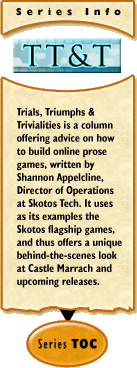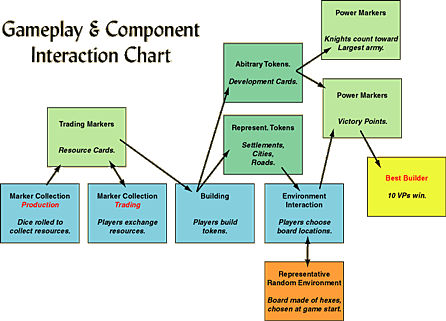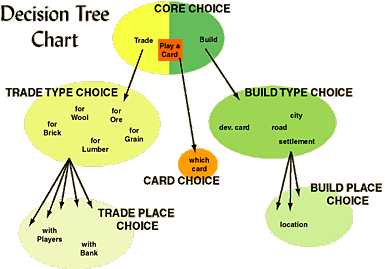
 Trials, Triumphs & Trivialities #107: Trials, Triumphs & Trivialities #107:
Anatomy of a Game: The Settlers of CatanFebruary 13, 2003 - For six weeks now, I've been going on about strategy games, and discussing how they work in some fairly abstract terms. This week I want to offer a little better specificity, by examining one game in-depth, seeing how it relates to the various terms I've been throwing around, and hopefully figuring out what makes it work.The victim is Klaus Teuber's The Settlers of Catan, which I've used for the occasional example along the way. The ComponentsUpon first opening The Settlers of Catan, it's obvious that the game includes a plethora of components. There are tokens and markers aplenty, along with a modular gameboard. The tokens are mostly representative tokens. Each player gets 5 settlements, 4 cities, and 15 roads to place on the map. There are also some arbitrary tokens in the form of a deck of development cards. Each of these gives the players specific powers; many of them later turn into power markers. (Before moving on, I also want to note that there's a special "robber token", which is a representative token that's moved by all of the players according to special rules. It thus is a "shared" token, something that I didn't mention in my original components article; any token in a game can either be shared or individual.) The gameboard is made up of hexes, which are all randomly assembled at the start of the game into an island. Each hex displays a specific type of land — forest, pasture, fields, hills, or mountains — and thus we can describe the board as a randomized representative environment. Closely associated with the board are resource cards, which are specific types of resources produced by the specific types of land. Forest produces lumber, pasture produces wool, fields produce grain, hills produce bricks, and mountains produce ore. These cards may be traded to other players or turned in to the bank to build the various types of tokens, thus making them trading markers. There are also a few victory point cards for "largest army" and "longest road", which are power markers. Finally, there are some rule cards which display what tokens can be built with what trading markers. These are not really a marker, but rather a different way to display the rules, and something that should be considered by a designer, because they're part of what makes this game successful and simple. Call it a rule marker, if you wish. The main pairing of components is clearly the representative tokens allied with the randomized environment, and in fact The Settlers of Catan was the game I used as my example of this pairing in my original components article. For more explanation of components, see Trials, Triumphs & Trivialities #102, Designing Strategy: The Components. Gameplay as Component InteractionsAs with most strategic games, the core rules for The Settlers of Catan concentrate on how the tokens, markers, and environment interrelate, and how these activities lead to victory. Trading Marker/Representative Token Interaction: The resource cards (trading markers) are what gets the game rolling. Each turn a player rolls two six-sided dice and from that determines which lands produce their resources. (Each hex has a number between 2 and 12 on it, and thus a hex produces resources of the appropriate type if its number is rolled.) During his turn, a player may then trade (exchanging his trading markers for other trading markers) or build (exchanging the trading markers for any of the tokens). There's a specific cost for each token, as shown below:
Representative Token/Environment Interaction: However, a player can't just build as he sees fit. Each token has specific rules that apply to how it can be placed on the environment. (Recall, as you read this, that the map of The Settlers of Catan is made up of hexes. Nothing is actually done in the centers of the hexes; rather all gameplay happens along the edges of those hexes, and at their points.)
Arbitrary Token Rules: The other token that can be built is the development card, an arbitrary token. There are no rules for the actual building of cards, because it just goes into your hand. However, it has specific rules involving how the card is used, such as the fact that only one may be played a turn. Beyond that, most cards in The Settlers of Catan themselves act as rules, which is pretty typical in any sort of complex strategic card game. More specifically, most cards define interactions with the other components of a game: the tokens, the markers, and the environment. The majority of the cards in The Settlers of Catan become power markers as soon as they're played. Some are victory points, while other contribute knights toward the "largest army" power marker. When I diagram out the entire game, in a moment, this is the focus I'll use for the arbitrary tokens. Other cards invoke marker collection gameplay by allowing you to steal trading markers from other players, and still others invoke building gameplay, by giving you new tokens to place on the board, but as noted these are the minority. Power Marker/Victory Interaction: Victory in the game is eventually determined by what tokens have been produced. Some of the tokens (settlements, cities, and some development cards are innately worth victory points, meaning that the token also acts as a power marker. For other tokens, the interaction is a causal relationship, meaning that having certain numbers of tokens qualifies the player to hold a power marker, such as "Longest Road" or "Largest Army". The whole chart looks like this:
The game ends at 10 VPs. Defining the GameplayLooking back at at our gameplay activities, we can see the following in The Settlers of Catan:
Moving on to gameplay victories, we can see that all of the possible victory points originate in how well the player has built tokens, thus we have a clear best builder victory. The main pairing in the gameplay is clearly the building activity allied with the best builder victory; as is the case with most gameplays, it's a direct activity to victory correlation. This is the same category that I'd placed Sid Meier's Civilization 3 in. Before I move on, though, I think it's somewhat instructive to chart out how the activities and victories in The Settlers of Catan interrelate. It looks something like this, using my abstracted terms (click diagram for larger version): I think the most interesting thing is this chart is how much back in forth we have between different types of gameplay and different components in a very hierarchical matter. I'll get back to that, because I think that's one of the things that makes The Settlers of Catan successful. I'll also note that I've simplified this chart to leave out some of the less common interactions, such as the "marker collection" gameplay which comes from a couple of the arbitrary tokens, and leads back to the trading markers, and the "building" gameplay which comes from another couple of arbitrary tokens, and leads back to representative tokens. These types of minor gameplay can be easily introduced to a game as long as they're tightly constrained — and only show up in certain, specific conditions. For more explanation of gameplay, see Trials, Triumphs & Trivialities #103, Designing Strategy: The Gameplay. Decision SetsI've already talked a fair amount about Catan's decision sets, in my original article on the topic; I'm going to rehash a lot of that, but also expand a little bit. There's a fairly clear tree of decisions within The Settlers of Catan, which I've outlined in the chart below (click diagram for larger version): You can at any time during your turn, play a card, so that's a core choice that's always available, but the other two choices are constrained by turn phase; you must do all your trading, then do all your building. Looking at trading, we see that only 5 different cards can be traded for. Further, these trades will be constrained by need; you're only going to trade for the stuff that you want to use to build, later in your turn. The decision of who to trade with is not a decision at all, because it's entirely constrained by attractiveness; you'll trade with either players or the bank, depending on who gives you a better ratio. Looking at cards, your decision set width will be equal to the number of cards you have. Because they can only be spent one per turn, you're unlikely to horde too many, lest you not be able to spend them all, thus this remains an easy decision. Looking at building, we see that only 4 different items can be built, and this is going to be constrained by ability, as you'll only be able to build that which you have the correct resources for. After you've decided what to build, you need to decide where to build it, and this is once more constrained by ability, which is to say those token/environment interactions that I described above, which give very precise rules for where to put things. It's also constrained by attractiveness, because some building sites will be better than others. It's worth noting that there is a result multiplier on building, because each token has an outcome on the environment, affecting what you'll be able to later build, and also has an outcome on the markers, affecting your total number of victory points. However, these two different results are largely constrained by game phase; you'll worry about environment effects early in the game, and marker effects later on. There is interaction between the different branches of the decision tree, which is something that I warned about as a possible way to add complexity to decisions, but everything is so tightly constrained that the game still works. You need specific trading markers to make specific tokens, and thus you'll try and attain the trading markers first, then try and use then to build tokens; it's a clear and linear set of decisions, which closely matches my outline for component & gameplay interaction, above. And, as is obvious from my chart, each individual decision set fits within the rule of 7, even before the various constraints I mentioned. What to trade for is the largest decision set, unconstrained, and that's only 5 wide. For more explanation of decisions, see Trials, Triumphs & Trivialities #105, Designing Strategy: Decision Sets. RandomnessThe Settlers of Catan has four different unpredictable events in the game. First, in game setup, you have weighted arbitrary unpredictability. The hexes to create the board are drawn from a random set of tiles and placed out in a specific manner. The unpredictability is notable for making every game different, but has less effect on the players, because they get to see all of the unpredictability resolve itself before they begin play. Second, prior to initial token placement, you have what amounts to unweighted, random unpredictability. Players roll dice to see who goes first, and no matter what die rolling technique is used, each player has a 1 in n chance of starting, where n is the number of players. The Settlers of Catan promptly moderates this chance element by instituting a specific way to place the starting tokens. The winning player places a settlement and a road, and placement continues clockwise until it gets to the last player, who places two settlement and two roads, and then placement continues back counterclockwise, with each other player placing their final road and settlement in turn. Thus, the winner player places first and last, while the last player actually places everything together. Third is the unpredictability that is the heart of the game, the production roll, which is curved, random unpredictability. This roll is totally unmoderated, but the board clearly displays which numbers are common (6 and 8) and which are uncommon (2 and 12), to help players understand how the curved distribution works. Fourth is the unpredictability caused by the development cards, which is a weighted, arbitrary unpredictability. You don't know exactly what card you might draw, but you do know the general weights of the different card types: knights are very common, and victory points are very rare. Together these unpredictable events all interact with the decision sets already described to form the core of The Settlers of Catan. For more explanation of unpredictability, see Trials, Triumphs & Trivialities #106, Designing Strategy: The Random Factor. An Analysis of SuccessWith all that said, I should probably note that The Settlers of Catan is a very successful board game. It's immensely popular in Germany, where it was originally produced, and does quite well in the United States too. It's also spawned close to a dozen expansions, supplements, and variant games. And, finally, just about everyone who plays it likes it quite a bit, with the exception of some of the most "serious", hardcore gamers. What makes it work? I'd have to start off by saying, quite simply, that it's pretty. There are lots of components, and they're nicely produced, and interesting to play with. The gameplay shows a good game design technique; it breaks activities into a hierarchical ladder which leads to victory. This is shown by the back and forth in my component & gameplay interaction chart: you product resources, and maybe trade them, which gives you tokens, which you place on the environment, which lead to victory. By breaking things down into steps (and every game does), you better control the width of decision sets through constraints, but you also clarify for players what they should be doing every step along the way. And, this also allows for a much more complex game, because you do have all those individual steps, and not just monochromatic gameplay. The decision sets are all carefully constrained, primarily as a side effect of the back-and-forth hierarchy I just described, but also due to the fact that many decisions can only be made if you have something or need something. Finally, we come to the randomness. Most of the randomness is moderated in some ways: you see the board beforehand, you know the composition of the development card deck (if you care), and which player goes first is made somewhat irrelevant... which only leaves the question of rolling for production. If the Settlers of Catan has any overall failing it's here. This is somewhat moderated, because if you need resource A, but instead get resource B, you can trade for it. However, there is the possibility to get a long string of bad luck where you get no resources, and this is enough randomness to spoil strategy, even if it doesn't happen that often. One of the Catan variant games, called The Settlers of Nurnberg, takes an interesting approach to moderating this problem by using cards instead of dice. An arbitrary unpredictability (the cards) can't have an infinitely long string of bad luck like a random unpredictability (the dice) can, and thus you still have chance occurrences, without them overpowering the strategy. Personally, I didn't like the tactile feeling of cards as much as dice, but it was an interesting technique, and one that's well worth considering, especially for web games where nothing is tactile. If I had one last thing to say on The Settlers of Catan's success it'd be this: it's easy. The rules are simple and clear, and the rules markers that I mentioned earlier do a good job of constantly conveying the core of those rules to the players. If a game designer, be he tabletop or web, can produce a similarly clean set of rules and constantly portray them to the players in an equally apt way, he'll already be on the path to success. ConclusionI like The Settlers of Catan. Because of the issues with randomness that I mentioned, it's not necessarily in my top 5 games of all time list, but it's up there, and I always have fun when I play it; I couldn't ask for much more. If you're interested in knowing more about The Settlers of Catan, and its game design, you may wish to take a look at the reviews I've written of the game and many expansions, while I was preparing for this article:
And as for next week, we'll be back to game design overview, this time talking about time. |

